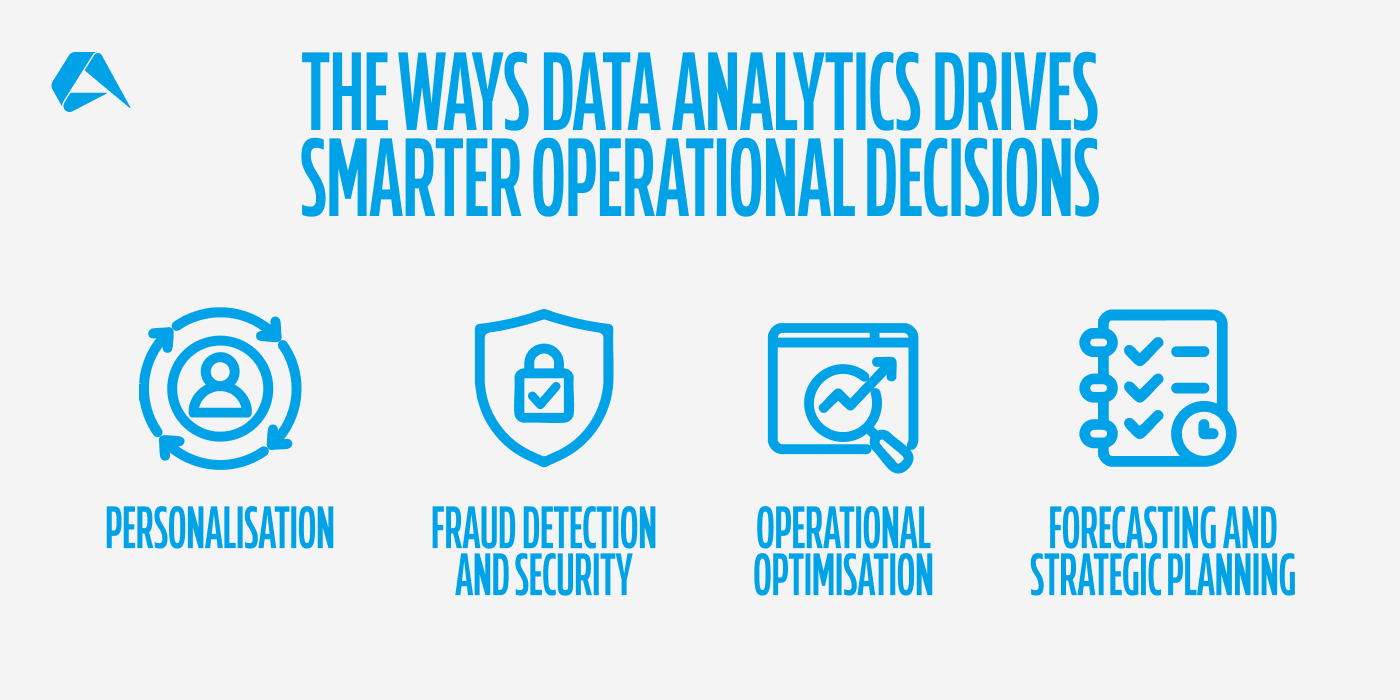Overview The Rise of Predictive Thinking in B2B iGaming
The B2B iGaming sector is undergoing a quiet revolution, evolving from reactive reporting to predictive analytics that actively shapes outcomes, identifying risk and adapting user journeys mid-session. Data is no longer just collected; the emphasis is on providing direction for smarter operational decisions.
Analytics underpins four primary areas. Personalisation uses real-time behavioural analysis (e.g., drop-off points) and dynamic content delivery powered by machine learning (e.g., Optimove’s Opti-X) to reduce churn and extend player lifetime value. Fraud Detection employs anomaly detection and behavioural clustering (e.g., Altenar's framework) to build player risk scores, proactively mitigating incidents before losses occur.
Furthermore, Operational Optimisation uses granular data, replacing instinct for decisions like odds-setting, and utilises automation for repeatable tasks based on predictive modelling. Forecasting leverages time-series modelling (e.g., Altenar's team) to anticipate betting volume spikes, informing resource allocation and strategic planning.
A competitive advantage is found in monitoring "shadow metrics" (like abandoned bet slips) which reveal player intent before headline KPIs. Ultimately, data is set to become the autonomous decision-maker, shifting the human role from analyst to architect.
Read the full blog for more details on how predictive analytics is reshaping the iGaming industry.
What if your next best decision wasn’t based on instinct, but on data so precise it knew what your players wanted before they did? That’s not hype. It’s the quiet revolution reshaping B2B iGaming from the inside out.
Across sportsbooks and casino platforms, data analytics is no longer just a reporting tool. It has evolved from post-event feedback to something far more influential, identifying risk before it happens, spotting drop-off before it begins, and adapting user journeys mid-session without a single manual touch. The real edge? Operators are no longer reacting to outcomes, they’re shaping them in advance.
Let’s explore how analytics is redefining decision-making across the iGaming sector, and not just in theory, but in practice. From shadow metrics to cross-operator intelligence, here’s how data is helping the industry think faster, act sharper, and win where it matters most.
The Ways Data Analytics Drives Smarter Operational Decisions

In today’s iGaming sector, data is at the heart of how businesses plan, act, and adapt. But it’s no longer just about collection. The emphasis is now on direction. The operators making the biggest gains aren’t those who gather the most data but those who know exactly what to do with it, often before their competitors see the trend coming.
From personalizing user journeys to detecting fraud, optimizing operations, and forecasting demand, analytics now underpins almost every wise decision that industry professionals make.
Here are the primary ways analytics reshapes operational thinking at every level.
Personalization
If you haven’t noticed the speed of evolution in data science, let’s be clear. The days of one-size-fits-all user journeys are over. Today, personalization is how smart operators write the rules of engagement. Modern B2B operators are expected to deliver real-time responses that feel hand-picked, without sacrificing scale or speed. At the heart of this shift lies behavioral analytics.
Real-Time Behavioral Analysis
By continuously tracking in-session data, like bet sizes, timing, browsing behavior, and drop-off points, operators can cluster users dynamically and trigger targeted interventions. That might mean surfacing a relevant betting market during a high-stakes match, sending a mid-game push offer tailored to recent activity, or adjusting bonuses based on a player’s lifecycle stage.
The short-term gains are obvious, though what matters more is how it lays the groundwork for lasting retention. When used intelligently, it builds trust and perceived value over time, two of the biggest predictors of long-term retention. It’s not guesswork. The outcomes are measurable - reduced churn, increased ARPU, and extended lifetime value.
Content Delivery
Responsiveness is just the first layer. What sets top platforms apart is their ability to balance responsiveness with foresight. So, let’s talk about dynamic content delivery. Instead of relying on fixed journeys, leading operators use machine learning to continually adapt the interface itself, in the form of surfacing bets, games, promotions, or even UX elements based on individual behavioral patterns. Optimove’s Opti-X platform, for example, applies AI models to predict what a player is likely to engage with next, feeding this data back into the UI in near real time.
The result is relevance and rhythm. Personalization becomes less about reacting and more about anticipating, shaping an experience that evolves with the player. And building systems that learn as fast as the players do is the real edge.
Fraud Detection and Security
Fraud in iGaming doesn’t always come through the front door. It invariably creeps in through duplicate accounts, bots posing as casual players, and bonus abuse hidden behind seemingly legitimate activity. The most proactive operators are doing more than responding to such incidents, they’re predicting them.
Anomaly Detection
Using anomaly detection powered by big data, operators can flag behavioral outliers the moment they appear. That might be an unusual number of account registrations from a single IP, a spike in deposits, or irregular betting patterns that suggest bot involvement.
It is worth noting that behavior doesn’t become suspicious in isolation. Patterns start to stand out only when layered against baselines, peer groups, and historical benchmarks. Altenar’s sportsbook analytics framework, for instance, identifies behavioral clusters that fall outside standard distribution curves, allowing for targeted investigation before losses occur.
Risk Mitigation
That same infrastructure plays a far broader role in risk mitigation. As predictive analytics matures, it’s moving from detection to prevention. Operators can now build player risk scores based on behavioral indicators and historical trends, proactively limiting exposure before an incident takes shape. And by learning from past anomalies and adjusting parameters in real time, advanced fraud detection tools become smarter with every use.
This kind of AI-assisted risk management does more than just help operators stay compliant. It protects profit margins, reputation, and long-term player trust while reducing the manual workload for compliance teams that have spent too long reacting after the event.
Operational Optimization
For many years, sportsbook operators and casino platforms have relied on instinct, historical averages, and post-event analysis to make decisions about odds-setting, promotions, and campaign planning. But those days are ending.
Data-Driven Decision Making
With granular data flowing in from every corner of the business, decisions that once involved guesswork can now be made with a high degree of accuracy. Operators no longer need to wonder which marketing message resonates or which betting markets consistently result in losses. The data answers that, often in real time.
The approach taken by iGaming solutions provider Altenar illustrates how operators use sportsbook analytics tools to help identify which markets are underperforming, where margin leakage is happening, and how external variables affect volumes and exposure across the board. The end goal isn’t just a better betting strategy. It’s operational clarity.
Process Automation
As more of those insights become consistent and repeatable, automation becomes the logical next step. Instead of manually adjusting line prices or launching segmented offers, operators are now building systems that do it automatically, which can be triggered by behavior thresholds, traffic spikes, or predictive modeling. The shift is evident in areas like bonus distribution, where AI models can identify players likely to convert with a personalized incentive and execute that reward instantly.
The result is a more agile and leaner operation where staff focus less on firefighting and more on high-value strategy.
Forecasting and Strategic Planning
In 2025, predicting the future in iGaming is no longer about gut feeling. Advanced data analytics uses pattern recognition at scale.
Trend Prediction
With historical data, real-time betting flow, and seasonal activity logs all feeding into central analytics engines, operators can now model trends with surprising accuracy. Whether it’s anticipating a spike in bets during the Champions League knockout stages or identifying quieter periods where acquisition campaigns may stretch further, data gives shape to decisions that used to rely on educated guesses.
One of the more practical applications of this is in the forecasting of profitable events. Altenar’s data analytics team uses time-series modeling to anticipate where betting volumes will concentrate down to the market level and week-on-week variations. That kind of visibility turns planning into a competitive advantage. Instead of reacting to demand, operators can prepare for it by calibrating odds ahead of time, adjusting promotional intensity, or even shifting media budgets to match projected peaks.
Resource Allocation
That level of forecasting doesn’t stop at marketing strategy. It informs resource allocation in a very real way. When operators know that traffic will surge midweek during international fixtures or spike on Friday nights for slots, they can adjust staffing, server bandwidth, customer support coverage, and bonus budgets accordingly.
Ultimately, predictive planning is about momentum. The more accurate the forecast, the more operators can invest, scale, and react with confidence. And in a market where delays cost money, foresight may be the single most underrated asset a sportsbook or casino can have.
Shadow Metrics
‘The Data Points That Reveal What KPIs Don’t’
Every operator tracks LTV, churn, and deposit frequency, but those metrics only tell half the story. Beneath the headline numbers lie shadow metrics. These behavioral signals and pain point indicators often surface long before a player drops off or a campaign underperforms. Such data points give operators the chance to intervene earlier, adjust smarter, and plan more precisely.
Take session pacing, for example. If a player who normally spends 30 minutes per session suddenly compresses that into a 7-minute flurry, it is highly suggestive that something’s changed. Maybe it's emotional fatigue, or perhaps it could be that the odds screen feels overwhelming. Either way, it’s a clue you won’t find in a churn report.
Likewise, win/loss volatility can reveal risk tolerance shifts or potential tilt, allowing platforms to moderate offers or intervene with safer suggestions. And then there’s intent scoring, an emerging favorite among data scientists, which tracks not just what a user does but what they nearly did. Hover patterns, aborted deposits, abandoned bet slips, and so on are essentially micro-signals that form the psychological fingerprints of player intent.
In practice, operators using shadow metrics often outperform those dependent solely on classic KPIs. Altenar’s Metrics That Matter article on performance metrics hints at this shift, suggesting that deeper, context-aware metrics are gaining ground as operators refine their targeting and retention models.
Ultimately, it is important to know that these aren’t simply vanity stats. They’re the quiet indicators that surface where decisions are actually being made, and for operators willing to dig deeper, they’re where real competitive advantage can be found.
Syndicated Operator Intelligence
‘Learning from Cross-Platform Trends’
When analyzed in isolation, even the best-performing data sets can mislead. What looks like a downturn might be a seasonal lull, and a surge could be nothing more than an outlier. This is where syndicated operator intelligence, which is anonymous, aggregated trend data drawn from across multiple operators, begins to reveal its value. Patterns gain clarity when viewed through a broader lens.
These pooled insights, typically powered by top-tier iGaming platform software providers like Altenar, enable operators to benchmark against industry averages without exposing proprietary data. For instance, a drop in conversion rate becomes more insightful when it’s clearly industry-wide. Similarly, a sharp rise in midweek in-play betting across regions might signal a trend worth jumping on, whether through new market offerings or targeted retention efforts.
This intelligence can also shape acquisition strategies. If specific demographics perform above baseline across similar platforms, operators can shift campaign budgets accordingly. It also clarifies the picture on player preferences, offering hints at game fatigue, bonus saturation, or shifting channel use that aren’t always visible when data is viewed in isolation.
That said, syndicated intelligence comes with limitations. The value lies in its anonymity, but that same mask can also obscure context. Operators must still ask questions like ‘who’s in the sample’ and ‘which markets are weighted more heavily’.
Beyond that, there are compliance considerations. Even anonymized data sharing must be managed within local data protection frameworks, especially in jurisdictions with evolving views on digital privacy.
This kind of aggregated intelligence, used carefully, helps operators play a smarter long game. Not by mimicking the competition, but by understanding the current situation and anticipating upcoming changes.
Final Thoughts: When Data Becomes the Decision-Maker
If current trends continue, data analytics in B2B iGaming may not just guide decisions but may soon become the decision-maker. As AI-driven models grow more confident, contextual, and autonomous, the human role shifts from analyst to architect. Operators will no longer just ask what the data says, they’ll define the rules for how the system responds, adapts, and evolves without intervention.
We’re already seeing this in areas like bonus optimization, fraud mitigation, and UX personalization, where real-time decisions are made by algorithms at scale. The central question now is not whether data can inform action, but whether it should own it.
Where Automation is Already Making Decisions
| Area of Operation | Automated Decision Example | Human Role Today |
|---|---|---|
| Bonus Distribution | Triggered by behavioural thresholds | Define conditions, monitor outcomes |
| Line Adjustments | Dynamic odds recalibration | Approve exceptions or edge cases |
| Risk Management | Fraud detection and betting pattern flagging | Investigate flagged anomalies |
| Player Retention Campaigns | Personalised offers based on predicted churn risk | Curate templates and review effectiveness |
| Content Surfacing | Bet/game suggestions based on real-time behaviour | Oversee layout strategy |
This, in turn, raises more questions. How much decision-making are we prepared to offload? Where is human oversight still essential? And how do we retain strategic creativity when many choices are made before we’ve even seen the data?
The future of iGaming may well belong to those who don’t just analyze the data, but teach it how to think.
Do you want to see what your current data might be missing? Schedule a demonstration of Altenar’s analytics suite today to understand how cross-platform insights and predictive modeling can drive smarter, faster operational decisions at every level.













